Starbucks in China: PESTLE and Porter's Diamond Analysis
VerifiedAdded on 2022/03/08
|11
|2763
|39
Report
AI Summary
This report provides a comprehensive analysis of the Chinese market for Starbucks, evaluating its potential for international expansion. The study begins with an executive summary and table of contents, setting the stage for an in-depth examination of the coffee industry in China. The report utilizes PESTLE analysis to assess the political, economic, social, technological, environmental, and legal factors influencing the business environment. Furthermore, it applies Porter's diamond model to evaluate the competitiveness of the coffee industry in China, considering demand conditions, factor conditions, related and supporting industries, and firm strategy, structure, and rivalry. The report identifies opportunities and risks for Starbucks, offering strategic recommendations for market entry and success, including focusing on higher profits, revenue growth, and long-term growth. The report emphasizes the importance of understanding consumer expectations, adjusting pricing strategies, and hiring local employees to navigate the Chinese market effectively. The analysis is supported by references to relevant academic sources.

International and Global Marketing (IGM)
Name of the student
Name of the university
Name of the student
Name of the university
Paraphrase This Document
Need a fresh take? Get an instant paraphrase of this document with our AI Paraphraser
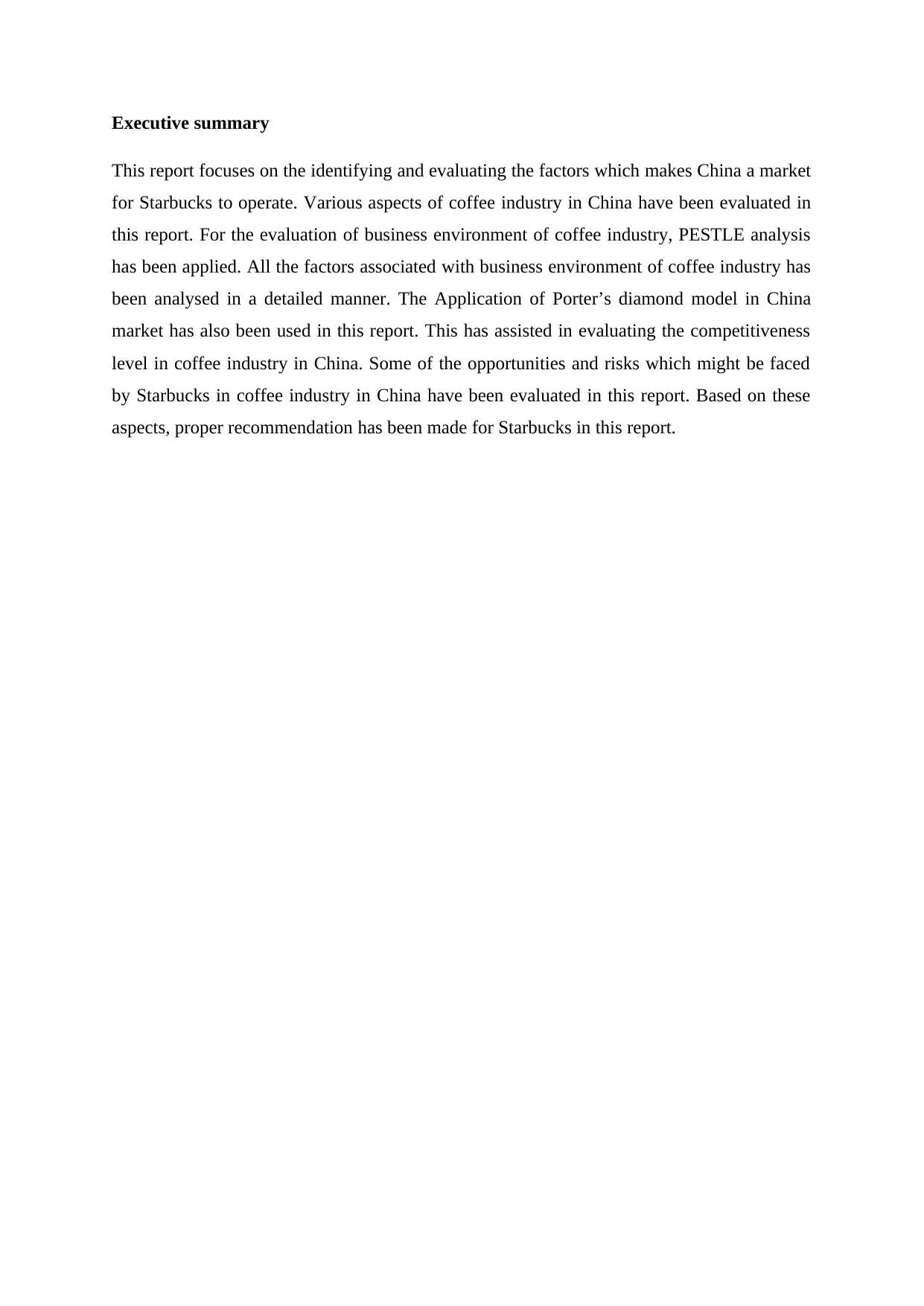
Executive summary
This report focuses on the identifying and evaluating the factors which makes China a market
for Starbucks to operate. Various aspects of coffee industry in China have been evaluated in
this report. For the evaluation of business environment of coffee industry, PESTLE analysis
has been applied. All the factors associated with business environment of coffee industry has
been analysed in a detailed manner. The Application of Porter’s diamond model in China
market has also been used in this report. This has assisted in evaluating the competitiveness
level in coffee industry in China. Some of the opportunities and risks which might be faced
by Starbucks in coffee industry in China have been evaluated in this report. Based on these
aspects, proper recommendation has been made for Starbucks in this report.
This report focuses on the identifying and evaluating the factors which makes China a market
for Starbucks to operate. Various aspects of coffee industry in China have been evaluated in
this report. For the evaluation of business environment of coffee industry, PESTLE analysis
has been applied. All the factors associated with business environment of coffee industry has
been analysed in a detailed manner. The Application of Porter’s diamond model in China
market has also been used in this report. This has assisted in evaluating the competitiveness
level in coffee industry in China. Some of the opportunities and risks which might be faced
by Starbucks in coffee industry in China have been evaluated in this report. Based on these
aspects, proper recommendation has been made for Starbucks in this report.
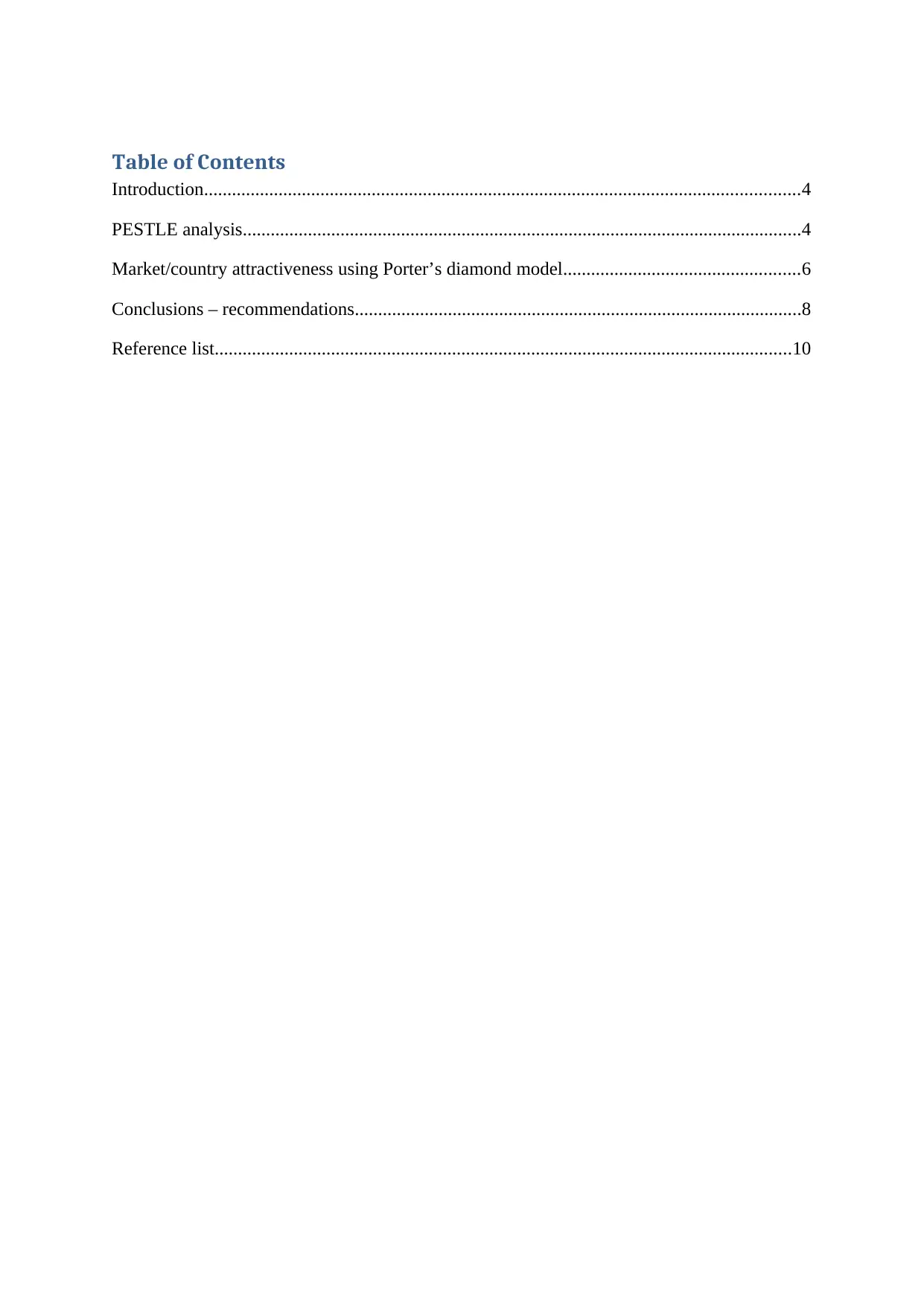
Table of Contents
Introduction................................................................................................................................4
PESTLE analysis........................................................................................................................4
Market/country attractiveness using Porter’s diamond model...................................................6
Conclusions – recommendations................................................................................................8
Reference list............................................................................................................................10
Introduction................................................................................................................................4
PESTLE analysis........................................................................................................................4
Market/country attractiveness using Porter’s diamond model...................................................6
Conclusions – recommendations................................................................................................8
Reference list............................................................................................................................10
⊘ This is a preview!⊘
Do you want full access?
Subscribe today to unlock all pages.

Trusted by 1+ million students worldwide
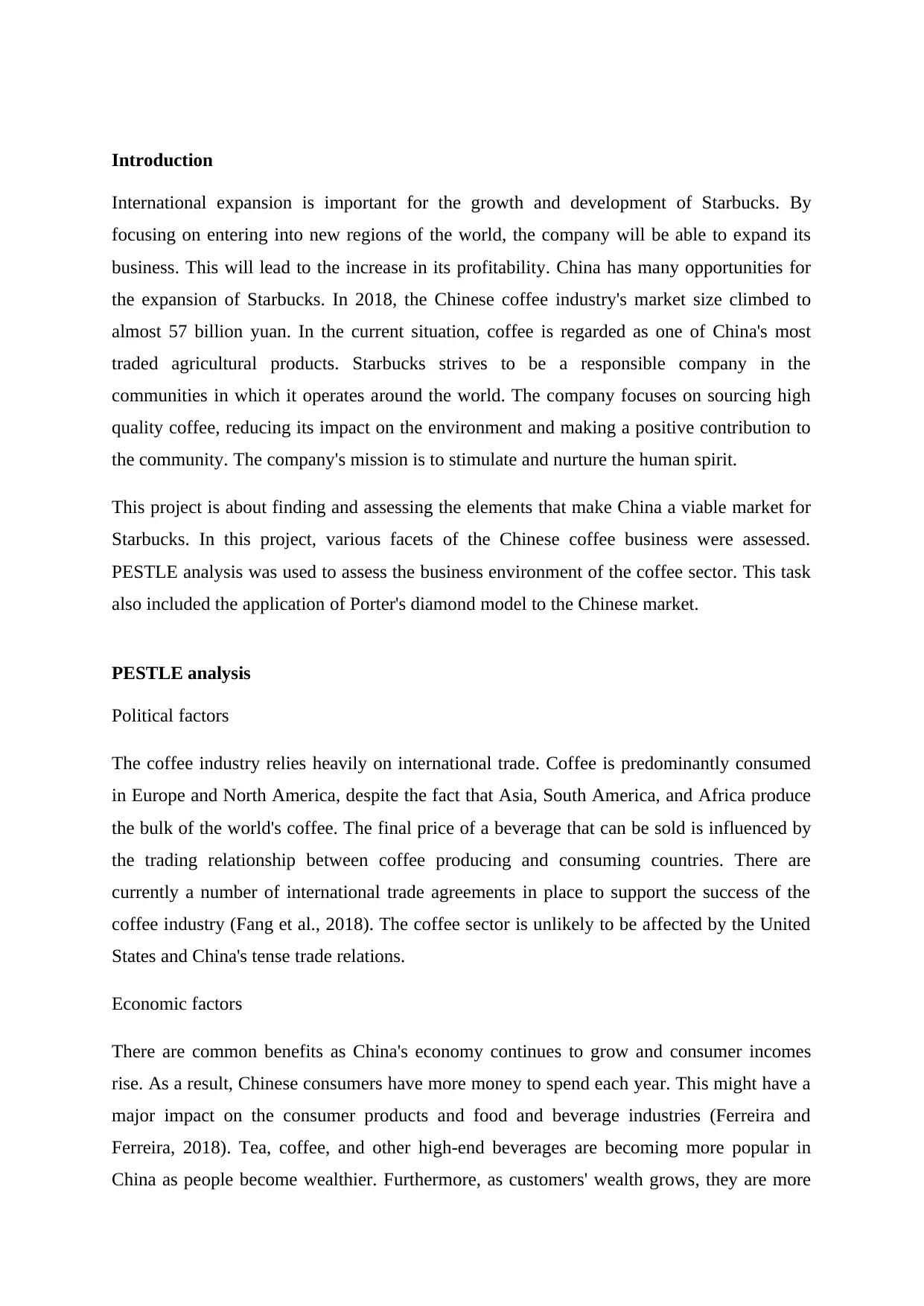
Introduction
International expansion is important for the growth and development of Starbucks. By
focusing on entering into new regions of the world, the company will be able to expand its
business. This will lead to the increase in its profitability. China has many opportunities for
the expansion of Starbucks. In 2018, the Chinese coffee industry's market size climbed to
almost 57 billion yuan. In the current situation, coffee is regarded as one of China's most
traded agricultural products. Starbucks strives to be a responsible company in the
communities in which it operates around the world. The company focuses on sourcing high
quality coffee, reducing its impact on the environment and making a positive contribution to
the community. The company's mission is to stimulate and nurture the human spirit.
This project is about finding and assessing the elements that make China a viable market for
Starbucks. In this project, various facets of the Chinese coffee business were assessed.
PESTLE analysis was used to assess the business environment of the coffee sector. This task
also included the application of Porter's diamond model to the Chinese market.
PESTLE analysis
Political factors
The coffee industry relies heavily on international trade. Coffee is predominantly consumed
in Europe and North America, despite the fact that Asia, South America, and Africa produce
the bulk of the world's coffee. The final price of a beverage that can be sold is influenced by
the trading relationship between coffee producing and consuming countries. There are
currently a number of international trade agreements in place to support the success of the
coffee industry (Fang et al., 2018). The coffee sector is unlikely to be affected by the United
States and China's tense trade relations.
Economic factors
There are common benefits as China's economy continues to grow and consumer incomes
rise. As a result, Chinese consumers have more money to spend each year. This might have a
major impact on the consumer products and food and beverage industries (Ferreira and
Ferreira, 2018). Tea, coffee, and other high-end beverages are becoming more popular in
China as people become wealthier. Furthermore, as customers' wealth grows, they are more
International expansion is important for the growth and development of Starbucks. By
focusing on entering into new regions of the world, the company will be able to expand its
business. This will lead to the increase in its profitability. China has many opportunities for
the expansion of Starbucks. In 2018, the Chinese coffee industry's market size climbed to
almost 57 billion yuan. In the current situation, coffee is regarded as one of China's most
traded agricultural products. Starbucks strives to be a responsible company in the
communities in which it operates around the world. The company focuses on sourcing high
quality coffee, reducing its impact on the environment and making a positive contribution to
the community. The company's mission is to stimulate and nurture the human spirit.
This project is about finding and assessing the elements that make China a viable market for
Starbucks. In this project, various facets of the Chinese coffee business were assessed.
PESTLE analysis was used to assess the business environment of the coffee sector. This task
also included the application of Porter's diamond model to the Chinese market.
PESTLE analysis
Political factors
The coffee industry relies heavily on international trade. Coffee is predominantly consumed
in Europe and North America, despite the fact that Asia, South America, and Africa produce
the bulk of the world's coffee. The final price of a beverage that can be sold is influenced by
the trading relationship between coffee producing and consuming countries. There are
currently a number of international trade agreements in place to support the success of the
coffee industry (Fang et al., 2018). The coffee sector is unlikely to be affected by the United
States and China's tense trade relations.
Economic factors
There are common benefits as China's economy continues to grow and consumer incomes
rise. As a result, Chinese consumers have more money to spend each year. This might have a
major impact on the consumer products and food and beverage industries (Ferreira and
Ferreira, 2018). Tea, coffee, and other high-end beverages are becoming more popular in
China as people become wealthier. Furthermore, as customers' wealth grows, they are more
Paraphrase This Document
Need a fresh take? Get an instant paraphrase of this document with our AI Paraphraser
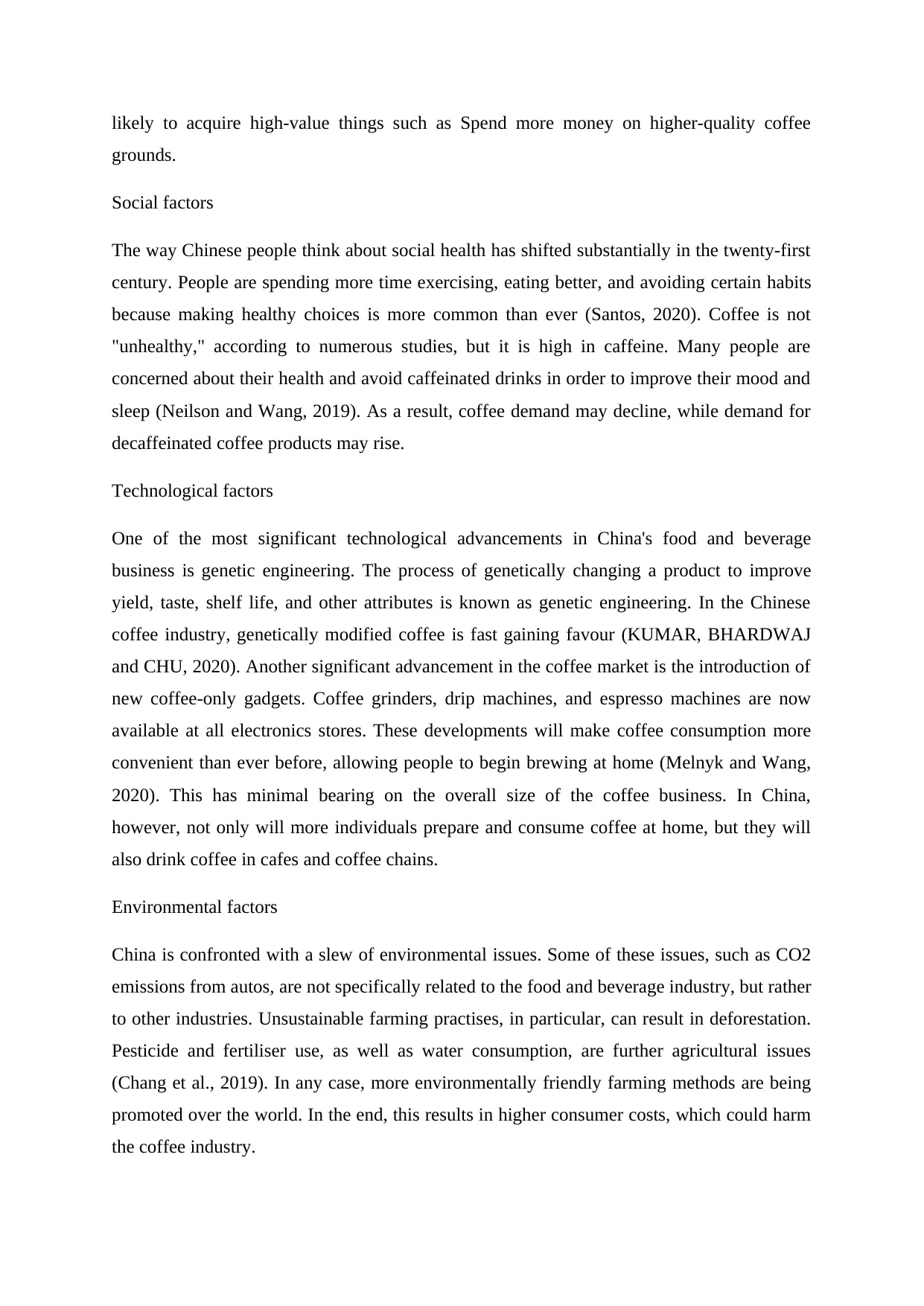
likely to acquire high-value things such as Spend more money on higher-quality coffee
grounds.
Social factors
The way Chinese people think about social health has shifted substantially in the twenty-first
century. People are spending more time exercising, eating better, and avoiding certain habits
because making healthy choices is more common than ever (Santos, 2020). Coffee is not
"unhealthy," according to numerous studies, but it is high in caffeine. Many people are
concerned about their health and avoid caffeinated drinks in order to improve their mood and
sleep (Neilson and Wang, 2019). As a result, coffee demand may decline, while demand for
decaffeinated coffee products may rise.
Technological factors
One of the most significant technological advancements in China's food and beverage
business is genetic engineering. The process of genetically changing a product to improve
yield, taste, shelf life, and other attributes is known as genetic engineering. In the Chinese
coffee industry, genetically modified coffee is fast gaining favour (KUMAR, BHARDWAJ
and CHU, 2020). Another significant advancement in the coffee market is the introduction of
new coffee-only gadgets. Coffee grinders, drip machines, and espresso machines are now
available at all electronics stores. These developments will make coffee consumption more
convenient than ever before, allowing people to begin brewing at home (Melnyk and Wang,
2020). This has minimal bearing on the overall size of the coffee business. In China,
however, not only will more individuals prepare and consume coffee at home, but they will
also drink coffee in cafes and coffee chains.
Environmental factors
China is confronted with a slew of environmental issues. Some of these issues, such as CO2
emissions from autos, are not specifically related to the food and beverage industry, but rather
to other industries. Unsustainable farming practises, in particular, can result in deforestation.
Pesticide and fertiliser use, as well as water consumption, are further agricultural issues
(Chang et al., 2019). In any case, more environmentally friendly farming methods are being
promoted over the world. In the end, this results in higher consumer costs, which could harm
the coffee industry.
grounds.
Social factors
The way Chinese people think about social health has shifted substantially in the twenty-first
century. People are spending more time exercising, eating better, and avoiding certain habits
because making healthy choices is more common than ever (Santos, 2020). Coffee is not
"unhealthy," according to numerous studies, but it is high in caffeine. Many people are
concerned about their health and avoid caffeinated drinks in order to improve their mood and
sleep (Neilson and Wang, 2019). As a result, coffee demand may decline, while demand for
decaffeinated coffee products may rise.
Technological factors
One of the most significant technological advancements in China's food and beverage
business is genetic engineering. The process of genetically changing a product to improve
yield, taste, shelf life, and other attributes is known as genetic engineering. In the Chinese
coffee industry, genetically modified coffee is fast gaining favour (KUMAR, BHARDWAJ
and CHU, 2020). Another significant advancement in the coffee market is the introduction of
new coffee-only gadgets. Coffee grinders, drip machines, and espresso machines are now
available at all electronics stores. These developments will make coffee consumption more
convenient than ever before, allowing people to begin brewing at home (Melnyk and Wang,
2020). This has minimal bearing on the overall size of the coffee business. In China,
however, not only will more individuals prepare and consume coffee at home, but they will
also drink coffee in cafes and coffee chains.
Environmental factors
China is confronted with a slew of environmental issues. Some of these issues, such as CO2
emissions from autos, are not specifically related to the food and beverage industry, but rather
to other industries. Unsustainable farming practises, in particular, can result in deforestation.
Pesticide and fertiliser use, as well as water consumption, are further agricultural issues
(Chang et al., 2019). In any case, more environmentally friendly farming methods are being
promoted over the world. In the end, this results in higher consumer costs, which could harm
the coffee industry.
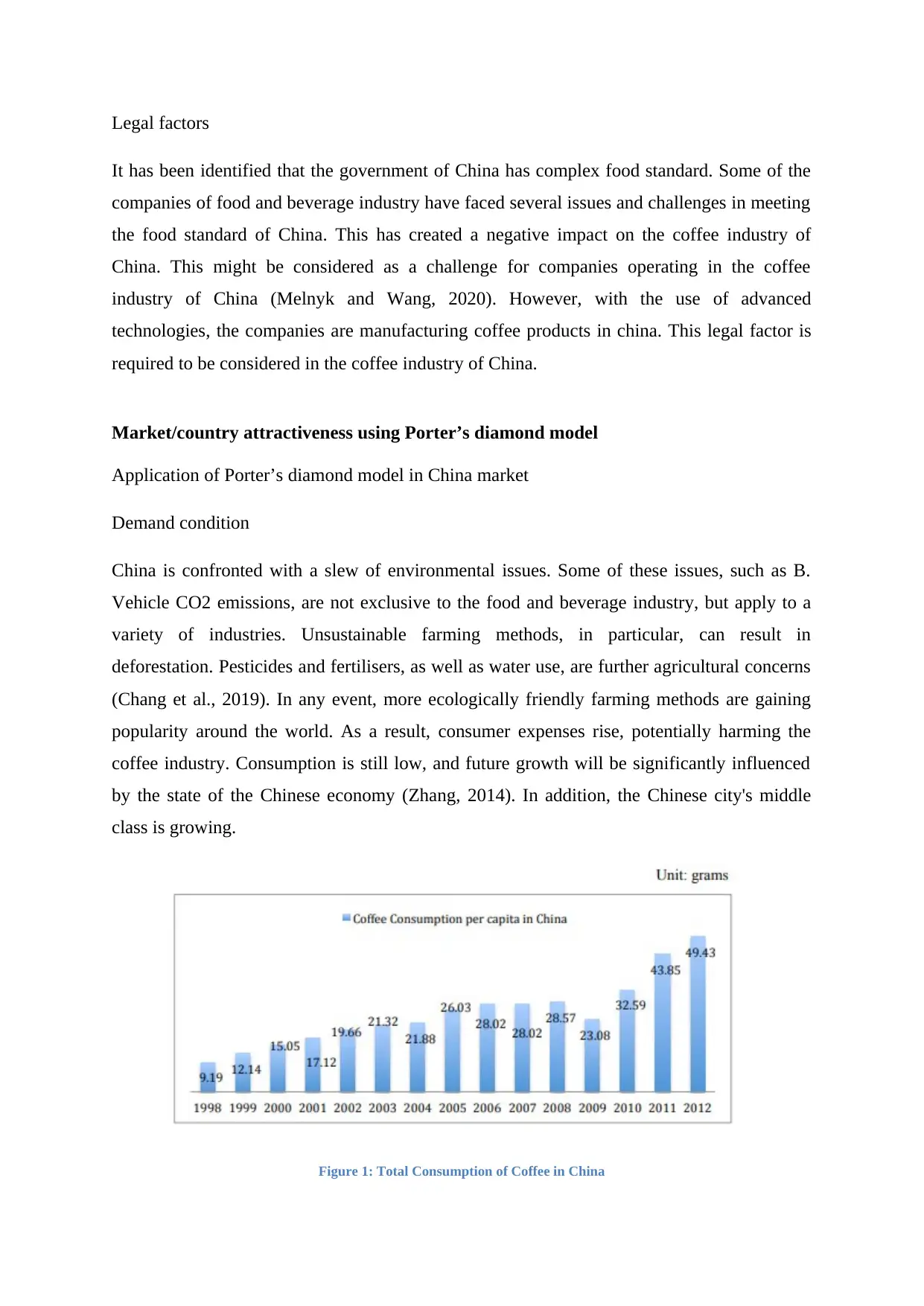
Legal factors
It has been identified that the government of China has complex food standard. Some of the
companies of food and beverage industry have faced several issues and challenges in meeting
the food standard of China. This has created a negative impact on the coffee industry of
China. This might be considered as a challenge for companies operating in the coffee
industry of China (Melnyk and Wang, 2020). However, with the use of advanced
technologies, the companies are manufacturing coffee products in china. This legal factor is
required to be considered in the coffee industry of China.
Market/country attractiveness using Porter’s diamond model
Application of Porter’s diamond model in China market
Demand condition
China is confronted with a slew of environmental issues. Some of these issues, such as B.
Vehicle CO2 emissions, are not exclusive to the food and beverage industry, but apply to a
variety of industries. Unsustainable farming methods, in particular, can result in
deforestation. Pesticides and fertilisers, as well as water use, are further agricultural concerns
(Chang et al., 2019). In any event, more ecologically friendly farming methods are gaining
popularity around the world. As a result, consumer expenses rise, potentially harming the
coffee industry. Consumption is still low, and future growth will be significantly influenced
by the state of the Chinese economy (Zhang, 2014). In addition, the Chinese city's middle
class is growing.
Figure 1: Total Consumption of Coffee in China
It has been identified that the government of China has complex food standard. Some of the
companies of food and beverage industry have faced several issues and challenges in meeting
the food standard of China. This has created a negative impact on the coffee industry of
China. This might be considered as a challenge for companies operating in the coffee
industry of China (Melnyk and Wang, 2020). However, with the use of advanced
technologies, the companies are manufacturing coffee products in china. This legal factor is
required to be considered in the coffee industry of China.
Market/country attractiveness using Porter’s diamond model
Application of Porter’s diamond model in China market
Demand condition
China is confronted with a slew of environmental issues. Some of these issues, such as B.
Vehicle CO2 emissions, are not exclusive to the food and beverage industry, but apply to a
variety of industries. Unsustainable farming methods, in particular, can result in
deforestation. Pesticides and fertilisers, as well as water use, are further agricultural concerns
(Chang et al., 2019). In any event, more ecologically friendly farming methods are gaining
popularity around the world. As a result, consumer expenses rise, potentially harming the
coffee industry. Consumption is still low, and future growth will be significantly influenced
by the state of the Chinese economy (Zhang, 2014). In addition, the Chinese city's middle
class is growing.
Figure 1: Total Consumption of Coffee in China
⊘ This is a preview!⊘
Do you want full access?
Subscribe today to unlock all pages.

Trusted by 1+ million students worldwide
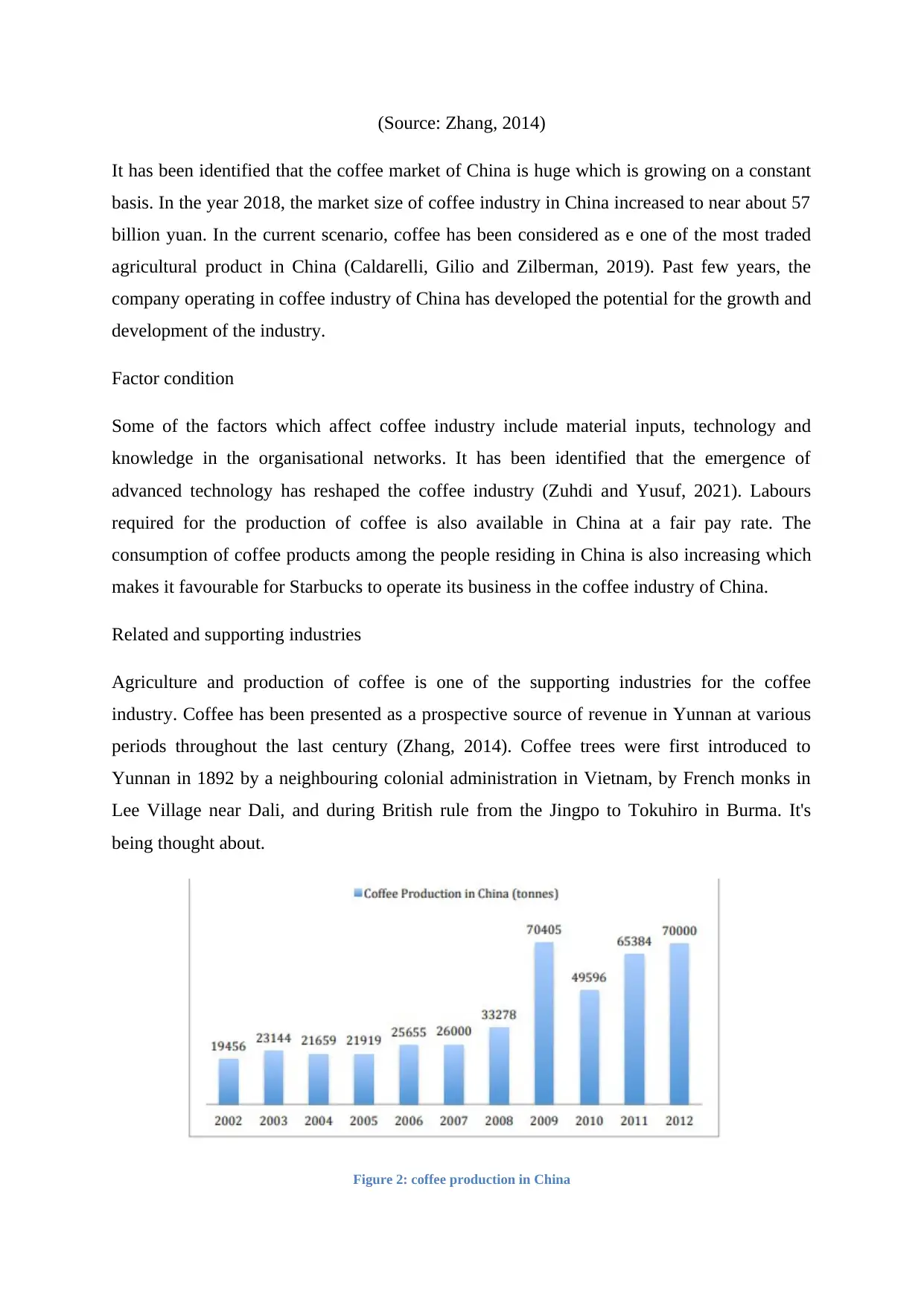
(Source: Zhang, 2014)
It has been identified that the coffee market of China is huge which is growing on a constant
basis. In the year 2018, the market size of coffee industry in China increased to near about 57
billion yuan. In the current scenario, coffee has been considered as e one of the most traded
agricultural product in China (Caldarelli, Gilio and Zilberman, 2019). Past few years, the
company operating in coffee industry of China has developed the potential for the growth and
development of the industry.
Factor condition
Some of the factors which affect coffee industry include material inputs, technology and
knowledge in the organisational networks. It has been identified that the emergence of
advanced technology has reshaped the coffee industry (Zuhdi and Yusuf, 2021). Labours
required for the production of coffee is also available in China at a fair pay rate. The
consumption of coffee products among the people residing in China is also increasing which
makes it favourable for Starbucks to operate its business in the coffee industry of China.
Related and supporting industries
Agriculture and production of coffee is one of the supporting industries for the coffee
industry. Coffee has been presented as a prospective source of revenue in Yunnan at various
periods throughout the last century (Zhang, 2014). Coffee trees were first introduced to
Yunnan in 1892 by a neighbouring colonial administration in Vietnam, by French monks in
Lee Village near Dali, and during British rule from the Jingpo to Tokuhiro in Burma. It's
being thought about.
Figure 2: coffee production in China
It has been identified that the coffee market of China is huge which is growing on a constant
basis. In the year 2018, the market size of coffee industry in China increased to near about 57
billion yuan. In the current scenario, coffee has been considered as e one of the most traded
agricultural product in China (Caldarelli, Gilio and Zilberman, 2019). Past few years, the
company operating in coffee industry of China has developed the potential for the growth and
development of the industry.
Factor condition
Some of the factors which affect coffee industry include material inputs, technology and
knowledge in the organisational networks. It has been identified that the emergence of
advanced technology has reshaped the coffee industry (Zuhdi and Yusuf, 2021). Labours
required for the production of coffee is also available in China at a fair pay rate. The
consumption of coffee products among the people residing in China is also increasing which
makes it favourable for Starbucks to operate its business in the coffee industry of China.
Related and supporting industries
Agriculture and production of coffee is one of the supporting industries for the coffee
industry. Coffee has been presented as a prospective source of revenue in Yunnan at various
periods throughout the last century (Zhang, 2014). Coffee trees were first introduced to
Yunnan in 1892 by a neighbouring colonial administration in Vietnam, by French monks in
Lee Village near Dali, and during British rule from the Jingpo to Tokuhiro in Burma. It's
being thought about.
Figure 2: coffee production in China
Paraphrase This Document
Need a fresh take? Get an instant paraphrase of this document with our AI Paraphraser
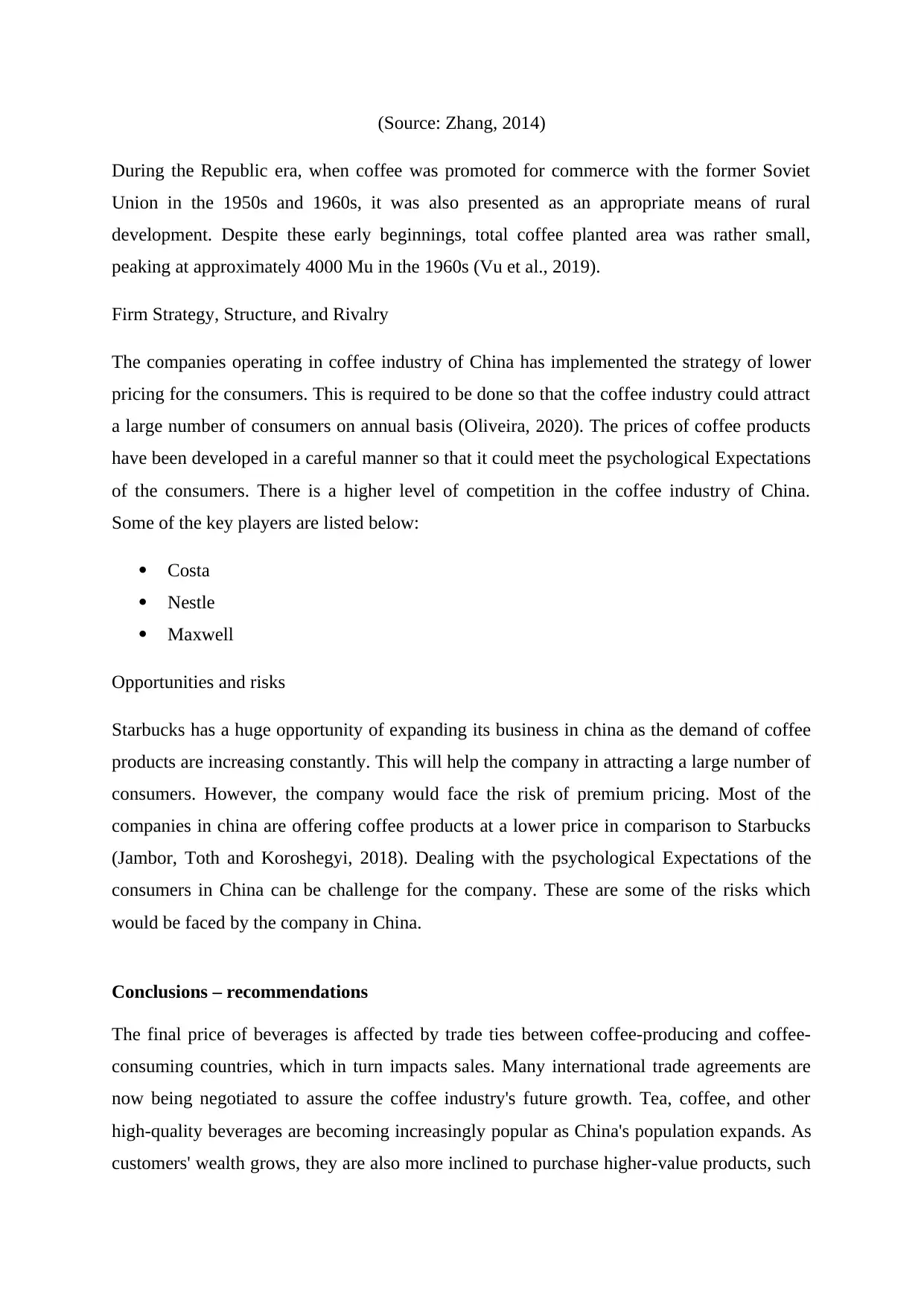
(Source: Zhang, 2014)
During the Republic era, when coffee was promoted for commerce with the former Soviet
Union in the 1950s and 1960s, it was also presented as an appropriate means of rural
development. Despite these early beginnings, total coffee planted area was rather small,
peaking at approximately 4000 Mu in the 1960s (Vu et al., 2019).
Firm Strategy, Structure, and Rivalry
The companies operating in coffee industry of China has implemented the strategy of lower
pricing for the consumers. This is required to be done so that the coffee industry could attract
a large number of consumers on annual basis (Oliveira, 2020). The prices of coffee products
have been developed in a careful manner so that it could meet the psychological Expectations
of the consumers. There is a higher level of competition in the coffee industry of China.
Some of the key players are listed below:
Costa
Nestle
Maxwell
Opportunities and risks
Starbucks has a huge opportunity of expanding its business in china as the demand of coffee
products are increasing constantly. This will help the company in attracting a large number of
consumers. However, the company would face the risk of premium pricing. Most of the
companies in china are offering coffee products at a lower price in comparison to Starbucks
(Jambor, Toth and Koroshegyi, 2018). Dealing with the psychological Expectations of the
consumers in China can be challenge for the company. These are some of the risks which
would be faced by the company in China.
Conclusions – recommendations
The final price of beverages is affected by trade ties between coffee-producing and coffee-
consuming countries, which in turn impacts sales. Many international trade agreements are
now being negotiated to assure the coffee industry's future growth. Tea, coffee, and other
high-quality beverages are becoming increasingly popular as China's population expands. As
customers' wealth grows, they are also more inclined to purchase higher-value products, such
During the Republic era, when coffee was promoted for commerce with the former Soviet
Union in the 1950s and 1960s, it was also presented as an appropriate means of rural
development. Despite these early beginnings, total coffee planted area was rather small,
peaking at approximately 4000 Mu in the 1960s (Vu et al., 2019).
Firm Strategy, Structure, and Rivalry
The companies operating in coffee industry of China has implemented the strategy of lower
pricing for the consumers. This is required to be done so that the coffee industry could attract
a large number of consumers on annual basis (Oliveira, 2020). The prices of coffee products
have been developed in a careful manner so that it could meet the psychological Expectations
of the consumers. There is a higher level of competition in the coffee industry of China.
Some of the key players are listed below:
Costa
Nestle
Maxwell
Opportunities and risks
Starbucks has a huge opportunity of expanding its business in china as the demand of coffee
products are increasing constantly. This will help the company in attracting a large number of
consumers. However, the company would face the risk of premium pricing. Most of the
companies in china are offering coffee products at a lower price in comparison to Starbucks
(Jambor, Toth and Koroshegyi, 2018). Dealing with the psychological Expectations of the
consumers in China can be challenge for the company. These are some of the risks which
would be faced by the company in China.
Conclusions – recommendations
The final price of beverages is affected by trade ties between coffee-producing and coffee-
consuming countries, which in turn impacts sales. Many international trade agreements are
now being negotiated to assure the coffee industry's future growth. Tea, coffee, and other
high-quality beverages are becoming increasingly popular as China's population expands. As
customers' wealth grows, they are also more inclined to purchase higher-value products, such
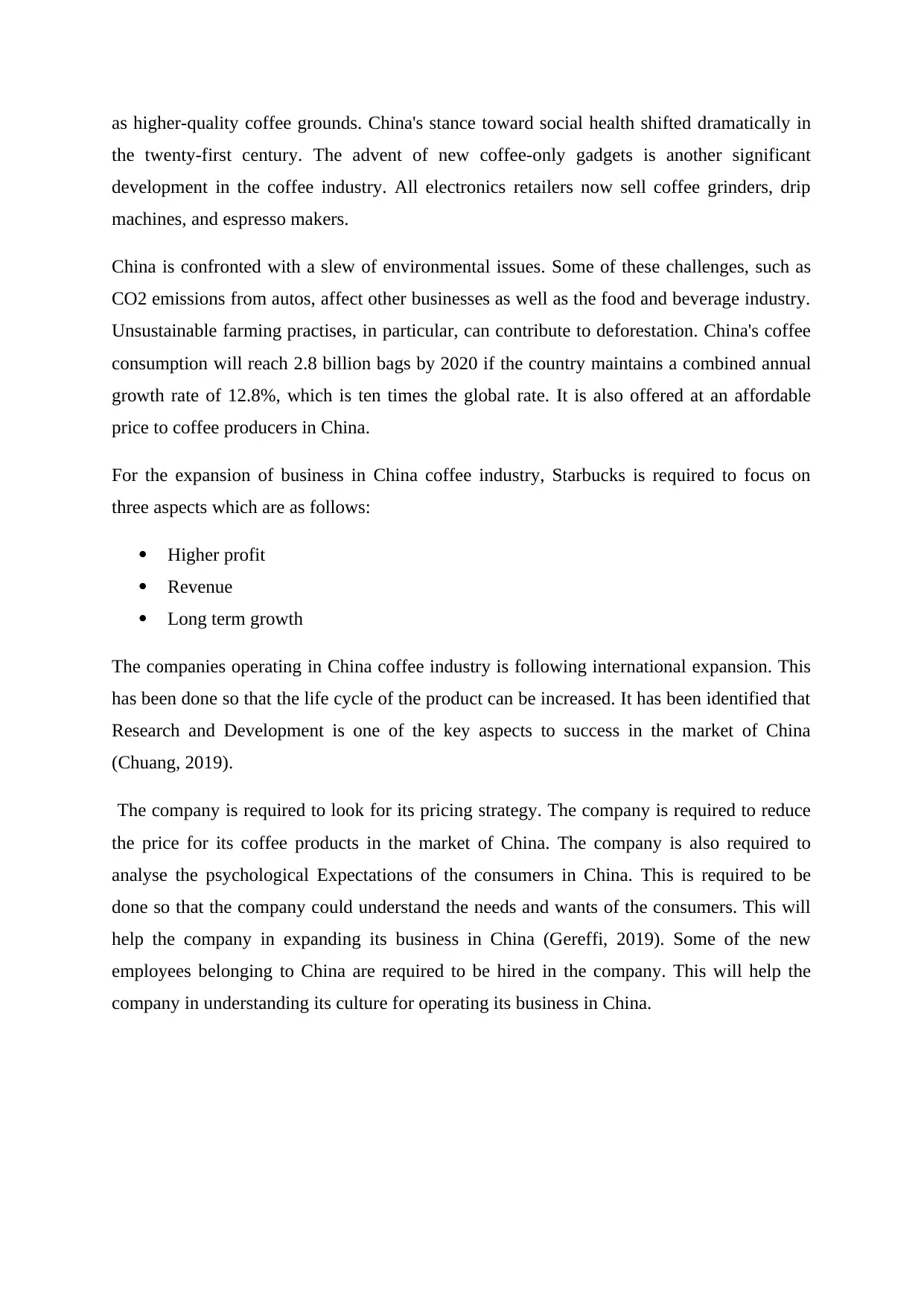
as higher-quality coffee grounds. China's stance toward social health shifted dramatically in
the twenty-first century. The advent of new coffee-only gadgets is another significant
development in the coffee industry. All electronics retailers now sell coffee grinders, drip
machines, and espresso makers.
China is confronted with a slew of environmental issues. Some of these challenges, such as
CO2 emissions from autos, affect other businesses as well as the food and beverage industry.
Unsustainable farming practises, in particular, can contribute to deforestation. China's coffee
consumption will reach 2.8 billion bags by 2020 if the country maintains a combined annual
growth rate of 12.8%, which is ten times the global rate. It is also offered at an affordable
price to coffee producers in China.
For the expansion of business in China coffee industry, Starbucks is required to focus on
three aspects which are as follows:
Higher profit
Revenue
Long term growth
The companies operating in China coffee industry is following international expansion. This
has been done so that the life cycle of the product can be increased. It has been identified that
Research and Development is one of the key aspects to success in the market of China
(Chuang, 2019).
The company is required to look for its pricing strategy. The company is required to reduce
the price for its coffee products in the market of China. The company is also required to
analyse the psychological Expectations of the consumers in China. This is required to be
done so that the company could understand the needs and wants of the consumers. This will
help the company in expanding its business in China (Gereffi, 2019). Some of the new
employees belonging to China are required to be hired in the company. This will help the
company in understanding its culture for operating its business in China.
the twenty-first century. The advent of new coffee-only gadgets is another significant
development in the coffee industry. All electronics retailers now sell coffee grinders, drip
machines, and espresso makers.
China is confronted with a slew of environmental issues. Some of these challenges, such as
CO2 emissions from autos, affect other businesses as well as the food and beverage industry.
Unsustainable farming practises, in particular, can contribute to deforestation. China's coffee
consumption will reach 2.8 billion bags by 2020 if the country maintains a combined annual
growth rate of 12.8%, which is ten times the global rate. It is also offered at an affordable
price to coffee producers in China.
For the expansion of business in China coffee industry, Starbucks is required to focus on
three aspects which are as follows:
Higher profit
Revenue
Long term growth
The companies operating in China coffee industry is following international expansion. This
has been done so that the life cycle of the product can be increased. It has been identified that
Research and Development is one of the key aspects to success in the market of China
(Chuang, 2019).
The company is required to look for its pricing strategy. The company is required to reduce
the price for its coffee products in the market of China. The company is also required to
analyse the psychological Expectations of the consumers in China. This is required to be
done so that the company could understand the needs and wants of the consumers. This will
help the company in expanding its business in China (Gereffi, 2019). Some of the new
employees belonging to China are required to be hired in the company. This will help the
company in understanding its culture for operating its business in China.
⊘ This is a preview!⊘
Do you want full access?
Subscribe today to unlock all pages.

Trusted by 1+ million students worldwide
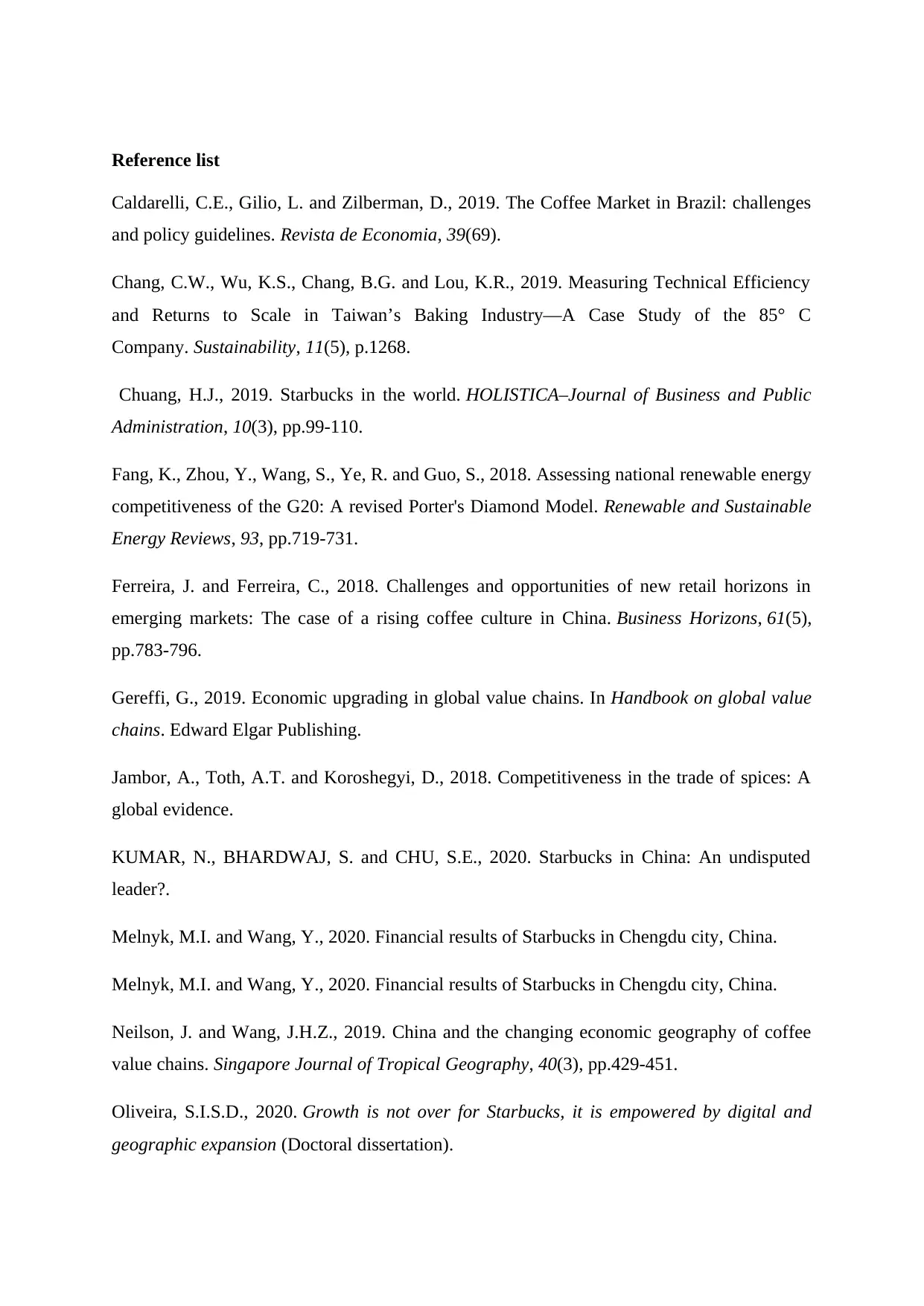
Reference list
Caldarelli, C.E., Gilio, L. and Zilberman, D., 2019. The Coffee Market in Brazil: challenges
and policy guidelines. Revista de Economia, 39(69).
Chang, C.W., Wu, K.S., Chang, B.G. and Lou, K.R., 2019. Measuring Technical Efficiency
and Returns to Scale in Taiwan’s Baking Industry―A Case Study of the 85° C
Company. Sustainability, 11(5), p.1268.
Chuang, H.J., 2019. Starbucks in the world. HOLISTICA–Journal of Business and Public
Administration, 10(3), pp.99-110.
Fang, K., Zhou, Y., Wang, S., Ye, R. and Guo, S., 2018. Assessing national renewable energy
competitiveness of the G20: A revised Porter's Diamond Model. Renewable and Sustainable
Energy Reviews, 93, pp.719-731.
Ferreira, J. and Ferreira, C., 2018. Challenges and opportunities of new retail horizons in
emerging markets: The case of a rising coffee culture in China. Business Horizons, 61(5),
pp.783-796.
Gereffi, G., 2019. Economic upgrading in global value chains. In Handbook on global value
chains. Edward Elgar Publishing.
Jambor, A., Toth, A.T. and Koroshegyi, D., 2018. Competitiveness in the trade of spices: A
global evidence.
KUMAR, N., BHARDWAJ, S. and CHU, S.E., 2020. Starbucks in China: An undisputed
leader?.
Melnyk, M.I. and Wang, Y., 2020. Financial results of Starbucks in Chengdu city, China.
Melnyk, M.I. and Wang, Y., 2020. Financial results of Starbucks in Chengdu city, China.
Neilson, J. and Wang, J.H.Z., 2019. China and the changing economic geography of coffee
value chains. Singapore Journal of Tropical Geography, 40(3), pp.429-451.
Oliveira, S.I.S.D., 2020. Growth is not over for Starbucks, it is empowered by digital and
geographic expansion (Doctoral dissertation).
Caldarelli, C.E., Gilio, L. and Zilberman, D., 2019. The Coffee Market in Brazil: challenges
and policy guidelines. Revista de Economia, 39(69).
Chang, C.W., Wu, K.S., Chang, B.G. and Lou, K.R., 2019. Measuring Technical Efficiency
and Returns to Scale in Taiwan’s Baking Industry―A Case Study of the 85° C
Company. Sustainability, 11(5), p.1268.
Chuang, H.J., 2019. Starbucks in the world. HOLISTICA–Journal of Business and Public
Administration, 10(3), pp.99-110.
Fang, K., Zhou, Y., Wang, S., Ye, R. and Guo, S., 2018. Assessing national renewable energy
competitiveness of the G20: A revised Porter's Diamond Model. Renewable and Sustainable
Energy Reviews, 93, pp.719-731.
Ferreira, J. and Ferreira, C., 2018. Challenges and opportunities of new retail horizons in
emerging markets: The case of a rising coffee culture in China. Business Horizons, 61(5),
pp.783-796.
Gereffi, G., 2019. Economic upgrading in global value chains. In Handbook on global value
chains. Edward Elgar Publishing.
Jambor, A., Toth, A.T. and Koroshegyi, D., 2018. Competitiveness in the trade of spices: A
global evidence.
KUMAR, N., BHARDWAJ, S. and CHU, S.E., 2020. Starbucks in China: An undisputed
leader?.
Melnyk, M.I. and Wang, Y., 2020. Financial results of Starbucks in Chengdu city, China.
Melnyk, M.I. and Wang, Y., 2020. Financial results of Starbucks in Chengdu city, China.
Neilson, J. and Wang, J.H.Z., 2019. China and the changing economic geography of coffee
value chains. Singapore Journal of Tropical Geography, 40(3), pp.429-451.
Oliveira, S.I.S.D., 2020. Growth is not over for Starbucks, it is empowered by digital and
geographic expansion (Doctoral dissertation).
Paraphrase This Document
Need a fresh take? Get an instant paraphrase of this document with our AI Paraphraser
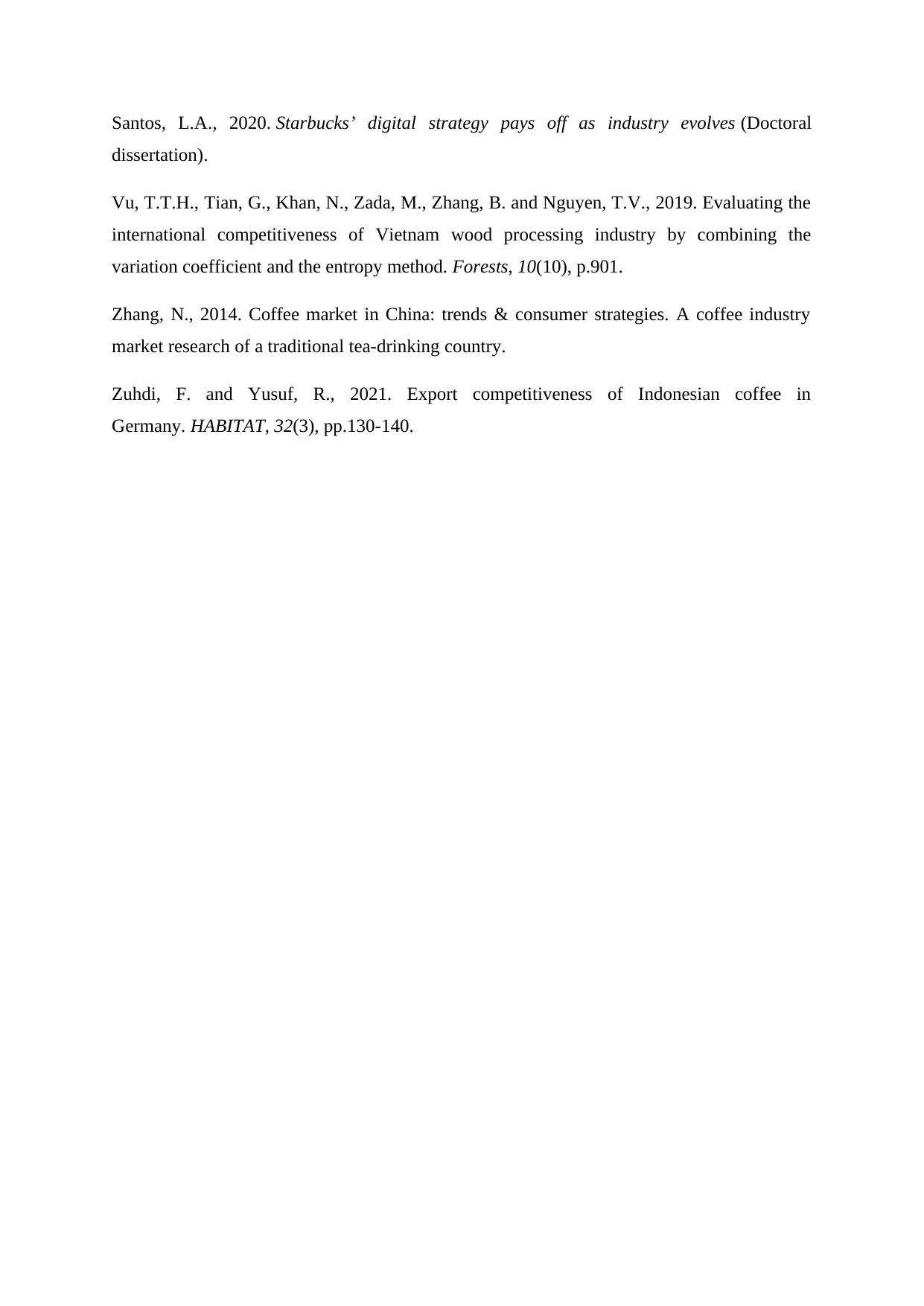
Santos, L.A., 2020. Starbucks’ digital strategy pays off as industry evolves (Doctoral
dissertation).
Vu, T.T.H., Tian, G., Khan, N., Zada, M., Zhang, B. and Nguyen, T.V., 2019. Evaluating the
international competitiveness of Vietnam wood processing industry by combining the
variation coefficient and the entropy method. Forests, 10(10), p.901.
Zhang, N., 2014. Coffee market in China: trends & consumer strategies. A coffee industry
market research of a traditional tea-drinking country.
Zuhdi, F. and Yusuf, R., 2021. Export competitiveness of Indonesian coffee in
Germany. HABITAT, 32(3), pp.130-140.
dissertation).
Vu, T.T.H., Tian, G., Khan, N., Zada, M., Zhang, B. and Nguyen, T.V., 2019. Evaluating the
international competitiveness of Vietnam wood processing industry by combining the
variation coefficient and the entropy method. Forests, 10(10), p.901.
Zhang, N., 2014. Coffee market in China: trends & consumer strategies. A coffee industry
market research of a traditional tea-drinking country.
Zuhdi, F. and Yusuf, R., 2021. Export competitiveness of Indonesian coffee in
Germany. HABITAT, 32(3), pp.130-140.
1 out of 11
Related Documents
Your All-in-One AI-Powered Toolkit for Academic Success.
+13062052269
info@desklib.com
Available 24*7 on WhatsApp / Email
![[object Object]](/_next/static/media/star-bottom.7253800d.svg)
Unlock your academic potential
Copyright © 2020–2025 A2Z Services. All Rights Reserved. Developed and managed by ZUCOL.



